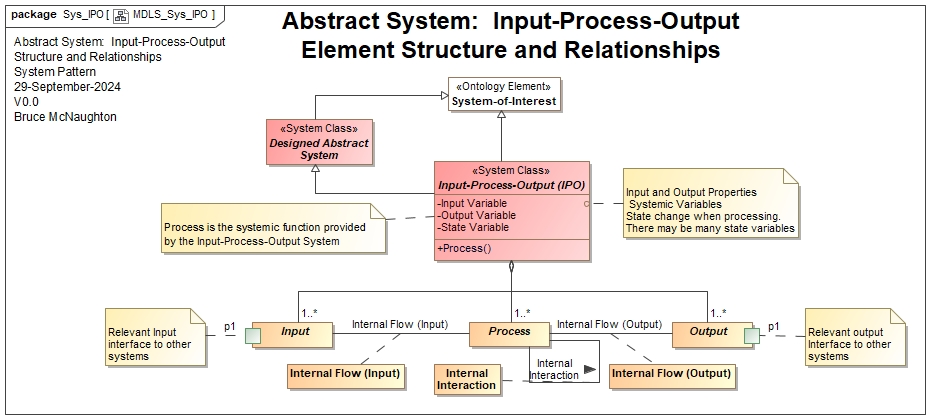Name: Input-Process-Output (IPO)
Based on: System (Abstract)
Abstract System: This system has been identified as an abstract system that cannot be implemented directly. The abstract system establishes a shared pattern of characteristics that any system can use to describe its unique characteristics when referenced in the 'based on' list above. These references are described using a generalization association in UML.
The Input-Process-Output (IPO) pattern is a basic system building block.
A Input-Process-Output (IPO) pattern provides a way to transform inputs into outputs. This pattern is a basic building block for a system or system element:
Systemic Measurable Variables
The emergent properties created or used through the interaction of the elements. This includes both desired and undesired.
The following are typical variables for a control system:
- Input: Input variable indicating the type of input and interface
- Output: the actual output value from the System.
NOTE: the names vary depending upon the actual process used.
Systemic Capabilities or Functions
The process is the defined function or capability of the Input-Process-Output (IPO) pattern.
System States
The various defined states that the system-of-interest can be in.
- Architectural states: Generally defined in the enabling system
- Transformational States Generally defined in an enabling or adaptive system associated with the control system.
- Operational States: These are typically initialising, Reference input change, stable, shutting down.
Identify the key stakeholders and their concerns for this system. Each stakeholder is identified and their concerns and interests are identified. The list below is an example. Each system will have a specific set of stakeholders and concerns.
- Owner / manager: Is this a sustainable / stable system? will our customers be satisfied?
- System Architect: Are the system concepts understood? Are the system properties sufficient to deliver the objectives? Is the feedback mechanism sufficient to maintain / track outputs / outcomes?
- People in the environment Will the people confirm or use the benefits of the system?
- Change Agents Do we have the ability to change the system in a planned way?
- People who are part of the system Will I understand my contribution to the system?
These stakeholders will depend upon the specific instance of this pattern.
The environment and the potential impacts on the system-of-interest.
This section includes
- Transactional: Ensure the delivery of the controlled output or respond to problems
- External Possible disruptions due to external factors: temperature, environment (e.g. flood, etc.).
- Regulator : Extra requirements or unexpected (magnitude or frequency) of changes to the reference inputs.
The Input-Process-Output (IPO) pattern may connect to systems in the environment. These systems must use the correct interface to connect to this pattern.
The specific details of the environment will be determined when a specific instance of this pattern is selected.
The following diagram shows the structure and relationships of an Input-Process-Output (IPO) System Conceptual Model.

This model of an Input-Process-Output (IPO) highlights the input and output system elements each with specific types of interfaces. The process system element may be simple (e.g. 1 process system element or multiple with internal interactions). The Process is the overall transformation. The state of the system is also important as there may be multiple states each may indicate the state of the flow through the system. The Internal Flow association may also include inhibitors or enablers to regulate the flows.
Configuration / Scenario:
Describes any configuration / scenario attributes for a specific system-of-interest. This may not be appropriate for all system descriptions (e.g. patterns or abstract systems).
Cyclical (Repeating / Regular) Processes
The processes to translate requirements and architecture into an operational system. An example of a set of life cycle processes can be found in ISO 15288.
NOTE: The Shannon Sampling Theorem applies to the dynamic behavior of the control system. If the sampling rate is too slow, the control system may become unstable or unable to control or regulate the process. The sampling rate is generally at least twice the underlying base frequency of the system being controlled.
Development Life Cycle Processes
This area describes the life cycle for creating, using or releasing a system. This allows for the replication of an existing system into other areas.
The following references support this type of system-of-interest.